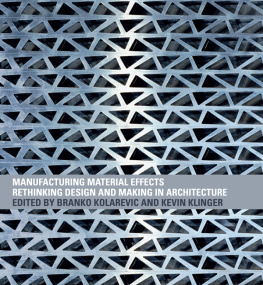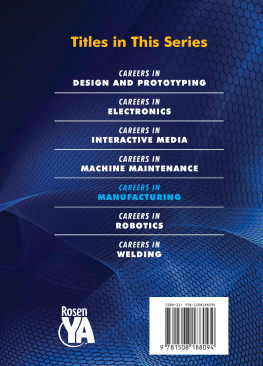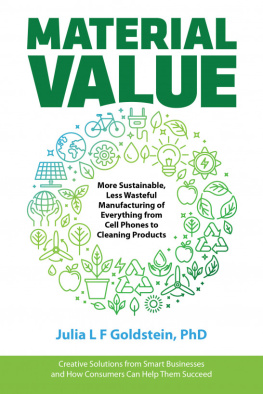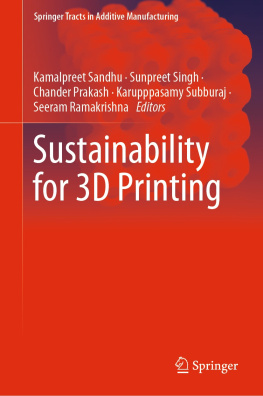Kolarevic - MANUFACTURING MATERIAL EFFECTS KOLA
Here you can read online Kolarevic - MANUFACTURING MATERIAL EFFECTS KOLA full text of the book (entire story) in english for free. Download pdf and epub, get meaning, cover and reviews about this ebook. publisher: Taylor and Francis, genre: Romance novel. Description of the work, (preface) as well as reviews are available. Best literature library LitArk.com created for fans of good reading and offers a wide selection of genres:
Romance novel
Science fiction
Adventure
Detective
Science
History
Home and family
Prose
Art
Politics
Computer
Non-fiction
Religion
Business
Children
Humor
Choose a favorite category and find really read worthwhile books. Enjoy immersion in the world of imagination, feel the emotions of the characters or learn something new for yourself, make an fascinating discovery.
MANUFACTURING MATERIAL EFFECTS KOLA: summary, description and annotation
We offer to read an annotation, description, summary or preface (depends on what the author of the book "MANUFACTURING MATERIAL EFFECTS KOLA" wrote himself). If you haven't found the necessary information about the book — write in the comments, we will try to find it.
MANUFACTURING MATERIAL EFFECTS KOLA — read online for free the complete book (whole text) full work
Below is the text of the book, divided by pages. System saving the place of the last page read, allows you to conveniently read the book "MANUFACTURING MATERIAL EFFECTS KOLA" online for free, without having to search again every time where you left off. Put a bookmark, and you can go to the page where you finished reading at any time.
Font size:
Interval:
Bookmark:
MANUFACTURING
MATERIAL EFFECTS:
RETHINKING DESIGN AND MAKING IN ARCHITECTURE
EDITED BY BRANKO KOLAREVIC & KEVIN R. KLINGER

First published 2008 by Routledge
270 Madison Avenue, New York, NY10016
Simultaneously published in the UK by Routledge
2 Park Square, Milton Park, Abingdon, Oxon, OX14 4RN
Routledge is an imprint of the Taylor & Francis Group, an informa business
2008 Branko Kolarevic & Kevin R. Klinger, selection and editorial matter; individual chapters, the contributors
All rights reserved. No part of this book may be reprinted or reproduced or utilised in any form or by any electronic, mechanical, or other means, now known or hereafter invented, including photocopying and recording, or in any information storage or retrieval system, without permission in writing from the publishers.
British Library Cataloguing in Publication Data
A catalogue record for this book is available from the British Library
Library of Congress Cataloging- in-Publication Data
A catalog record for this book has been requested
ISBN10 0-415-77574-4 (hbk)
ISBN10 0-415-77575-2 (pbk)
ISBN13 978-0-415-77574-8 (hbk)
ISBN13 978-0-415-77575-5 (pbk)
CONTENTS
We thank with the deepest gratitude the contributors to this book their creative ideas and their highly innovative work were the main inspiration for this volume and the eponymous symposium that preceded it. In April 2007, we gathered in Indianapolis for two days to examine the synergetic relationships between design and making in architecture and the increasing attention devoted to intricate, often complex effects in material and surface articulation. The intention of the symposium content and the ensuing discussions have been refined and captured in this book.
The Manufacturing Material Effects (MMFX) symposium (www.bsu.edu/imade/mmfx) was organized by the Institute for Digital Fabrication at Ball State University (BSU) and held at the Indianapolis Museum of Art (IMA) on April 6 and 7, 2007. We are most grateful to the symposium sponsors: Autodesk, Inc., McGraw-Hill Construction Information Group, autodessys, Inc., Bentley Systems, Inc., IMA and Center for Media Design and College of Architecture and Planning at Ball State University; without their support, the symposium and this book would not have been possible. Major funding for the initial formative research was provided through the Center for Media Design; our deepest gratitude to the Lilly Endowment for their funding of research and educational initiatives at BSU.
We are profoundly appreciative of Ball State University, a unique institution at the crossroads of the Midwest. We are particularly grateful to Jo Ann Gora, the University President, David Ferguson, Director of the Center for Media Design, Joseph Billelo, former Dean of the College of Architecture and Planning, Jon Coddington, former Chair of the Department of Architecture, and the Irving Distinguished Professorship for the inspiration, encouragement and support of our work. We also want to thank the Indianapolis Museum of Art, Maxwell Anderson, the Museum Director, and Linda Duke, Director of Education, for embracing this project from its inception, for providing a platform for its success, and for encouraging and hosting a follow-up exhibition in the spring of 2008 with the help of David Russick, David Chalfie, Rosanne Winings, Sue Ellen Paxson, Andy Stewart, and the rest of the IMA staff.
At the University of Calgary, we would like to express our gratitude to Loraine Fowlow, Interim Dean of the Faculty of Environmental Design, and the Haworth Research Chair Professorship in Integrated Design, for their support in the later stages of this project. The production of the book was supported in part through a grant from the Graham Foundation for Advanced Studies in the Fine Arts.
Finally, and most importantly, we want to thank our students and our colleagues for the stimulating conversations about the subject of this book. In particular, we want to acknowledge Joshua Vermillion at Ball State University for his ideas, enthusiasm, hard work, and infallible support in our efforts. We also want to thank the students who were involved with the ideas, content, and organization of the symposium and subsequent activities and Jennifer Weaver Cotton for minding many details.
We are grateful to Caroline Mallinder at Taylor and Francis for her enthusiastic support of this project and Katherine Morton for patiently navigating the editing of the manuscript and production of the book. Special thanks to Frank Barkow of Barkow Leibinger Architects for kindly providing us with an image for the book cover.
At a personal level, we are indebted (in so many ways) to our spouses; our special thanks to Stephanie LaBeau Sisco Klinger and Vera Parlac, respectively, for their patient support during the endless refinement and crafting of this project, and to our boys, J. Wesley and Ethan Frederick Klinger, and Marko Parlac Kolarevic, for allowing us to focus attention on this work during the formative years of their lives. This book is dedicated to them.
Kevin R. Klinger and Branko Kolarevic
Indianapolis and Calgary, Spring 2008
Brett Steele
Architectural Association
The future is already here. Its just unevenly distributed.
(William Gibson)
Modern architecture came into being as something first glimpsed, later recognized, and finally capitalized upon thanks to a bunch of clunky, often awkward and frequently just-plain-lucky prototypes.
The legacy of twentieth-century architectural innovation is that of countless stumbling discoveries by people calling themselves architects who were especially at the outset of their careers often paying the bills by doing something else entirely. Consider a quick laundry list of examples: Mies van der Rohes glass-and-metal working model of the 1917 Friedrichstrasse Tower, where he claimed: I had to make the model using the buildings actual materials just to learn what the reflective qualities would be like, or his later series of 1:1 villa mock-ups or wall-sized simulations, assembled over and over again at countless expositions and exhibitions before actually building a full live piece of architecture. We have Le Corbusiers child-like wire and string toy model of the Brussels Pavilion (visualizing the form of ruled-surface structure), or around the same time Charles and Ray Eamess plywood splints pressed out of the Kazaam machine in a back bedroom of their Los Angeles apartment. Consider Antonio Gauds material computers assembled as inverted form-finding chain models consisting of hundreds of carefully arranged weights and cords, or Frei Ottos no-less complex analogue model, a stereoscopic photography set-up that he designed to record and analyze the essential loading experiments applied to cable models of his Munich stadium. Scanning the history of modern architectures underlying prototypers we come across quirky inventor-figures like the French craftsman-engineer Jean Prouve with a sheet-metal bending press (purchased at the outset of his setting up his own office; a kind of rapid-prototyping machine of the 1930s). Or we have, at the ideological end of modernisms revolutionary impulse, Vladimir Tatlins massive timber tests of his never-realized Monument to the Soviets. The birth of corporate architecture is no less prototype-bound: remember the large-scale mock-ups and testing that went into the invention of an odd one-off steel and aluminum cleaning cradle that had to be designed on the fly in order for SOM to realize the Lever House, the worlds first all-glass tower in the early 1950s. More recently, consider the career trajectory of Frank Gehry and how it was sent in new directions only after he grabbed on to cheap corrugated cardboard as the ideal working material for a line of furniture whose experimental forms profoundly changed his subsequent architectural work (including especially that of his own Venice house, assembled as a hands-on, full-scale, constantly re-arranging prototype in the architects thinking in the 1970s).
Next pageFont size:
Interval:
Bookmark:
Similar books «MANUFACTURING MATERIAL EFFECTS KOLA»
Look at similar books to MANUFACTURING MATERIAL EFFECTS KOLA. We have selected literature similar in name and meaning in the hope of providing readers with more options to find new, interesting, not yet read works.
Discussion, reviews of the book MANUFACTURING MATERIAL EFFECTS KOLA and just readers' own opinions. Leave your comments, write what you think about the work, its meaning or the main characters. Specify what exactly you liked and what you didn't like, and why you think so.










